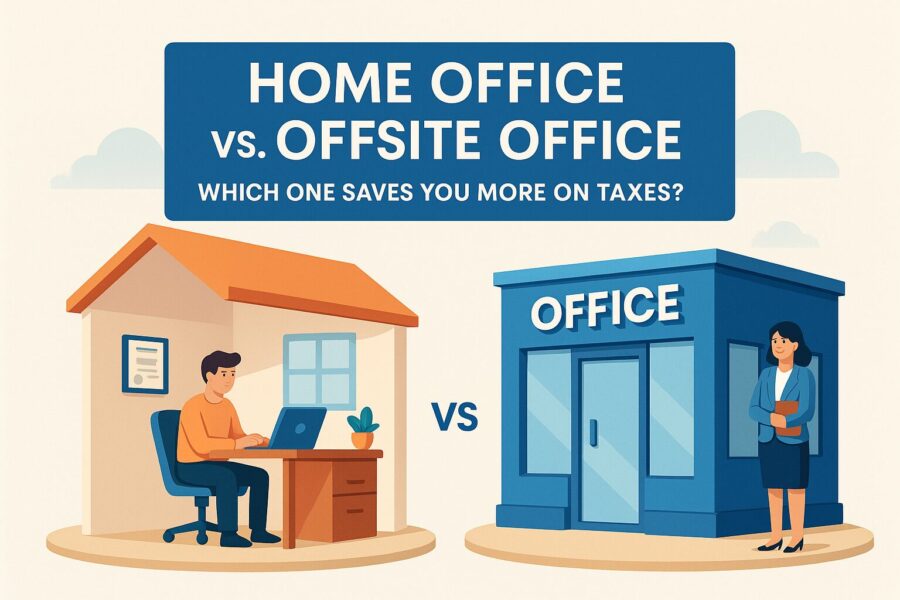If you’re running a small business, chances are you’ve asked yourself this question:
“Should I keep working from home or invest in an office space?“
From a tax perspective, both setups have their pros and cons. But here’s the catch… the “best” choice isn’t just about how much you deduct. It’s also about how you work, what your business needs, and how you want to grow. and to some extent, your personal preference.
BTW: I’ve already written a small article about this subject — and it may be a great place to start. You can find it HERE. If you want to learn more about the benefits of an administrative office, you can find that article HERE.
Let’s unpack the tax rules, explore how the IRS treats each setup, and walk through a few real-life examples so you can make the smartest decision for your business — and your wallet.
Working From Home: The IRS Sees Everything
Most entrepreneurs think they can just claim a home office because they send emails from their kitchen or take calls from the couch. But the IRS has rules — and they’re very specific.
Of course the IRS has a guide to all of this… you can find it HERE.
To qualify for the home office deduction, your space must be used regularly and exclusively for your business, and it must be your principal place of business. That means your guest bedroom can’t double as a workout room. And if your kids are doing homework at the kitchen table you work from, it doesn’t count. The IRS wants a clearly defined space dedicated to work and nothing else.
Once you’ve got that set up, there are two ways to calculate your deduction. The first is the simplified method — $5 per square foot, up to 300 square feet, for a maximum deduction of $1,500. The second is the actual expense method, which allows you to deduct a percentage of your home expenses (such as mortgage interest, rent, utilities, insurance, repairs, and even depreciation) based on how much space your office takes up.
For example, if your office occupies 10% of your home’s square footage and your eligible expenses total $25,000, your deduction would be $2,500.Offsite Office: Bigger Bills, Bigger Write-Offs
Now imagine you lease a 1,000-square-foot office across town. You’re paying $1,800 a month in rent. You’ve furnished the space, added some branding touches, and you meet clients there regularly. You even hired a part-time assistant to help manage foot traffic and administrative tasks.
All of that, from rent and utilities to the furniture, coffee machine, and cleaning service, becomes a fully deductible business expense. Since the space is entirely separate from your personal residence, there’s no need to prove exclusivity. The IRS generally accepts these expenses without issue, as long as they’re ordinary and necessary for your business.
Let’s do the math: rent ($21,600/year), internet ($1,200), utilities ($2,000), furniture ($3,500), and cleaning ($1,800)… that’s $30,100 in annual deductions just from your office setup. That’s a significant tax write-off compared to the average home office. But remember, that also means you’re spending more in real dollars. This strategy only works if your revenue supports the overhead.
IRS Audit Risk: What the Data Says
There’s a persistent myth that claiming a home office is a red flag for audits. There is some truth to this — particularly when the deduction seems unusually high relative to your income, or when it’s combined with other audit triggers like excessive vehicle write-offs or ongoing business losses.
Still, if you keep good records and the deduction is reasonable, there’s nothing inherently risky about it. On the flip side, offsite office deductions tend to raise fewer questions. They’re cleaner and easier to verify.
In general, the more your workspace doubles as personal space, the more scrutiny it invites. A home office that’s clearly used only for business (with photos, a floor plan, and consistent usage) is less likely to cause problems than one that’s used for multiple purposes.
When a Home Office Makes Sense
Home offices tend to work best for solo operators who don’t host clients in person. If you’re a coach, consultant, or creative who can do most of your work from a laptop (and you’re not looking to hire anytime soon) working from home is often the most cost-effective path. It also supports those who need flexibility, like parents, caretakers, or early-stage startups trying to keep expenses lean.
In higher-cost cities, a home office can be significantly cheaper than leasing space elsewhere. The key is to make sure the space is used only for business. Take photos. Save your bills. If you own your home, be aware of depreciation recapture — the IRS may tax the portion of your home that was depreciated when you sell it.
When an Offsite Office Is the Better Move
As your business grows, so do your space needs. If you have employees or plan to hire soon, you’re probably better off in a separate office. Offsite setups also work well for those who meet clients in person or need a professional setting. If your home is limited in size or full of distractions, an external office can boost productivity and brand image.
Let’s say you run a small agency. You have three team members and a few local clients. Renting a dedicated space allows you to host meetings, collaborate with staff, and maintain clear separation between work and home. And from a tax perspective, the deductions are larger and easier to justify.
If you buy a building instead of renting, you may even be able to cost-segregate the property (if you meet the criteria). That means you accelerate depreciation on parts of the building (like lighting or fixtures), which can drastically reduce your tax bill in the early years.
What About Having Both?
YES — in some cases, you can have both a home office and an offsite location. But the IRS is very specific about how this works. You can only claim the home office deduction if you use the space for administrative or managerial work — and you don’t do that same work at your other location.
For instance, if you meet clients at your downtown office but do all your bookkeeping, strategic planning, and admin tasks at home, you may qualify for both deductions. But if your admin work happens at the offsite office, the home office likely doesn’t count.
One common move is to work from home but maintain a co-working membership (at a third party site) for client-facing tasks. These blended models require careful planning, documentation, and guidance from a seasoned tax strategist.
Real-World Example: Coach A vs. Agency B
Coach A is a solo business coach who works from her home office — a spare bedroom converted into a workspace. She hosts Zoom sessions, writes client reports, and handles billing and content from that room. Her home expenses total $30,000 a year, and her office takes up 12% of her living space. That gives her a $3,600 deduction using the actual expense method, plus other write-offs like internet and supplies.
Agency B is a creative firm with three employees. They lease a 1,000 sq ft office downtown. Their rent is $2,500 per month. When you add in utilities, office decor, cleaning, and furniture, they’re writing off over $40,000 a year in office-related expenses.
Both setups are smart. But each one reflects a different business model. One is optimized for solo simplicity; the other is built for team collaboration and client interaction.
So Which One Saves You More in Taxes?
If we’re only looking at deductions, offsite offices usually win. The potential write-offs are bigger and easier to justify. But that doesn’t mean they save you more in the long run. You’re still spending a lot more cash upfront.
If you don’t truly need the space, you’re paying a dollar to save 30 cents. A home office, while limited in deduction size, keeps your overhead lean and allows you to reinvest profits into growth. But at the same time, there is a possibility to utilize the space in your house (otherwise not used for anything else) and be reimbursed for ti by the business.
Here’s the smarter way to think about it: What supports your daily workflow? What helps you grow more efficiently? What lets you serve your clients better — while keeping the IRS happy?
The right answer is the one that aligns with your business goals, not just your tax return. In the end, regardless of your choice, you should always work with a tax strategist to find the optimal solution for you — and your business.
Welcome to the New Age of Accounting. Let’s begin.

Chris is the Managing Partner at Weston Tax Associates, a best-selling author, and a renowned tax strategist. With over 20 years of expertise in tax and corporate finance, he simplifies complex tax concepts into actionable strategies that drive business growth. Originally from Sweden, he now lives in Florida with his wife and two sons.








